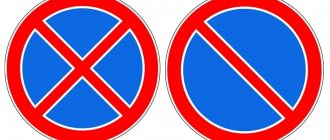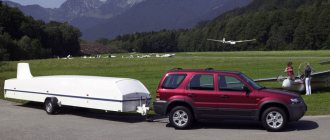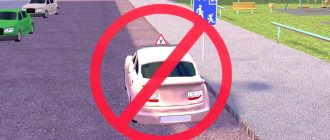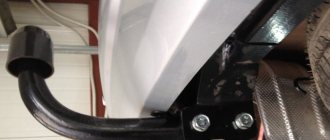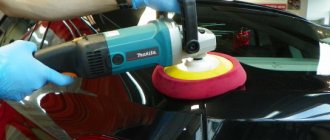Towing a vehicle with a flexible hitch
Towing a car with a flexible hitch is the most common method of towing passenger cars.
A flexible hitch, which is usually a fabric cable, is present in the trunk of almost every car owner. And the point here is not that drivers care about the problems of possible towing. Usually the cable, along with a fire extinguisher, a warning triangle and a first aid kit, is included in the motorist’s kit, so it willy-nilly ends up in almost any trunk.
An example of towing with a flexible hitch is shown in the following picture:
In practice, in addition to the towing cable, special towing mounts will also be required. On some cars, the mounts are lugs that stick out from under the bumpers. On others, you should use a special loop that is screwed into the mount under the plug in the bumper.
It is with a flexible hitch that category B cars are most often towed.
Towing a car
Before starting transportation, agree with the other driver about the route, speed of travel and the signs that will need to be given, for example, for an unscheduled stop.
Before starting transportation, agree with the other driver about the route, speed of travel and the signs that will need to be given, for example, for an unscheduled stop.
A vehicle towed on a flexible hitch must have a working brake system and steering system. Transportation speed - no more than 50 km/h. You must also remember that towing is prohibited in icy conditions.
On a towed vehicle, you must turn on the ignition so that the mechanical steering lock does not work when turning. Therefore, we recommend disconnecting the low voltage wire from the ignition coil - this will save battery charge. In addition to the emergency signal, the driver of a broken down car may also need a horn, and in the rain, windshield wipers. All this requires energy, and it must be conserved.
What should it be
What is necessary for successful and authorized transportation of a vehicle by towing:
- Serviceability of brake and steering systems.
- Integrity of the body covering - there should be no breaks or pointed pieces bent outward (if the car has been in an accident).
- Serviceability of door hinges, handles, glass.
- Carabiners and other elements of the connecting device must be in good working order.
- A flexible clutch requires a certain length of cable.
- For rigid fastening - a special device made of durable and high-quality metal.
When transporting a passenger car, a flexible hitch option is suitable. But to transport a truck or passenger vehicle, a rigid hitch is required.
With the latter type of towing, the trajectory of the second vehicle will not deviate. Thus, during travel there will be no unnecessary interference for other participants.
Rope length
The cable should not be shorter than 4 meters and longer than 5 meters. It should be taken into account that the longer the flexible clutch equipment is, the greater the risk of deviation of the trajectory when moving.
If the cable is shorter than the specified norm, then there is a high risk of a collision between the driven vehicle and the vehicle pulling it.
The color of the cable does not matter. The accumulation of steel fibers is impregnated with reflective compounds.
In the case of using a red and white cable with a “reflector” effect, it is allowed not to attach striped signs. Such cables themselves signal and serve as a means of issuing warning signals.
Most often you can find products made from threads of the following shades and their combinations:
- red;
- orange;
- blue;
- blue and white;
- white with red;
- orange and white;
- other variations.
Speed also plays a role in the presence of a particular length of cable. Even driving slowly by the lead driver will not allow the trailing motorist to drive perfectly smoothly.
This is why it is required that the second (transported) car be driven by a person who is always ready to correct the motion vector in a timely manner.
Travel speed
The main postulate of the Rules regarding the speed limit applies to almost all types of vehicles and in all cases of towing. One rule applies to everyone.
Permitted speeds when towing another vehicle:
| within the boundaries of the village | no more than 50 km/h |
| outside the city, town, along the highway | no higher than 40 km/h |
| in case of independent movement of the coupled car | no more than 80 km/h |
| with attached trailer | no more than 70 km/h |
If a car has an automatic transmission and is subject to forced removal from its location on the roadway, then it must be driven exclusively at a speed of 30 km/h - no more.
The only thing is that if the number of gears is more than 3 stages, it is allowed to transport the vehicle at an increased speed, but not more than 50 km/h.
Features of a rigid coupling
This method of towing is carried out using a solid structure, one end of which is attached to the driving vehicle, the other to the driven one. It allows both vehicles to be kept on the same line while driving, which ensures reliability and safety.
Therefore, a rigid vehicle coupling is especially useful for moving heavy, clumsy equipment. It will prevent cars from colliding with each other.
Inventions
Mercedes-Benz has invented an electronic collar for trailers. The new system is called Trailer Stability Assist (TSA). It is fully integrated into the vehicle's existing electronic stability control system. TSA quickly detects the beginning of a skid or lateral sway of the trailer and effectively suppresses these movements by alternately braking the right and left front wheels of the vehicle.
Not all drivers are familiar with the rules for towing vehicles: in driving schools little time is devoted to this section, and in practice, not many have tested themselves as a driver of a towing or towed vehicle.
In a real traffic situation, the lack of theoretical and practical knowledge causes certain difficulties.
Rules for towing with a rigid hitch
Towing a vehicle with a rigid hitch
First of all, traffic regulations prohibit towing in any case if the steering of the towed vehicle is faulty - it can only be transported by partial or full loading. Sometimes they write that when hitching with three attachment points, it is not necessary for the driver to be behind the wheel of the towed car - this is an erroneous idea that contradicts the requirements of the traffic rules.
The driver of the towing vehicle must have at least 2 years of driving experience. The dimensions of the rigid coupling must be such that the distance between the machines is no more than 4 meters. The weight of a towed vehicle with a non-working brake system should not exceed half the weight of the “tug”.
Towing a car - rules and types of towing
Towing a car , in layman's terms, is the transportation of one vehicle (practically a “passenger”) to another. The need for towing occurs when there is a sudden failure or breakdown of the vehicle's control systems. For example, as a result of an accident, when the car receives serious external and internal damage.
General rules for towing vehicles
— Transportation by tow requires the towing vehicle to have auxiliary technical means and equipment , as well as a sufficiently highly qualified driver.
-The towing vehicle must have low beams , and the towed vehicle must have an hazard warning light (if it is faulty, an “Emergency Stop” sign must be attached).
— The transportation of passengers in the cabin of the towed and towing vehicles is prohibited due to a decrease in their operational reliability.
motorcycles as towing vehicles .
— The towing speed should not exceed 50 km/h (for vehicles with a manual transmission) and 30 km/h (for vehicles with an automatic transmission).
— For cars with automatic transmission there are also restrictions on the length of the towing distance of up to 30-80 km. , if the wheels of the towed vehicle are “driving” on the road. In this case, the gear shift lever must be set to the “N” (neutral) position. This limitation is caused by the design features of the automatic transmission to avoid overheating of the transmission oil.
Transporting a car by tow can be done in several ways. Let's take a towing methods .
Towing with a rigid hitch
In this case, the role of the connecting element is a special cylindrical metal rod, or a towing structure consisting of two rods connected at an angle (“triangle”).
This type of towing is not suitable for moving passenger cars, because their design does not provide places for attaching a rather heavy rigid rod.
Rules for towing with a rigid hitch:
— The length of the towing rod should not exceed 4 meters .
— The driver of the towed vehicle must be behind the wheel in order to adhere to the trajectory, however, with a triangle hitch this is not necessary (although it is desirable).
— Towing vehicles with faulty steering on a rigid hitch is prohibited .
— Towing with a rigid hitch is permissible in icy conditions when driving on a slippery road.
Towing with a flexible hitch
In order to tow with a flexible hitch, you should use a nylon or steel cable as a connecting link. By the way, a nylon halyard is in no way inferior to a steel one (for example, in strength). Under load, the nylon halyard begins to stretch. Thanks to this, the likelihood of damaging body parts is reduced, and breaking or deformation of the towing eyes becomes almost impossible.
But the nylon cable also has a drawback: if it sag too much, it will most likely rub off on the asphalt. True, now this “minus” has been eliminated, thanks to the creation of a special protective sheath for the nylon cable. The shell itself is also quite flexible. The use of this design does not allow the nylon halyard to sag (even in cases where a minimum distance of 1.5-2 meters is formed between cars).
Rules for towing with a flexible hitch:
— The length of the cable for a flexible coupling should not exceed 4-6 meters .
— The tow rope should not sag or touch the road .
— In order to visually indicate the cable, you should use 2 flags (at least), the size of which is 215 by 200 mm, they should be painted with white and red stripes diagonally 50 mm wide.
— The driver of the towed vehicle must be behind the wheel in order to adhere to the trajectory and a certain distance.
— Towing with a flexible hitch is prohibited if the steering and/or braking system of the towed vehicle is impaired.
— Towing on a flexible hitch is prohibited in icy conditions.
Towing by partially or fully loading the vehicle
A tow truck is used as an auxiliary vehicle, equipped with a special loading platform and equipment to lift and securely secure the transported vehicle.
This type of towing is precisely used when cars are driving in icy conditions, with faulty steering and a failed brake system. That is, in all cases where towing with a flexible or rigid hitch is prohibited.
For cars with automatic transmission, due to the above-mentioned design features, towing is usually used by fully loading it onto a tow truck.
As a result of an accident, a car often requires serious body repairs. You can learn more about professional body repair on the website www.avtort.ru.
Read with this article:
How to paint a car bumper
How to get payments from the insurance company after an accident
Ten ways to save fuel in a car with automatic transmission
Detailing - your car is brand new again
Towing with a rigid hitch
Unlike towing with a flexible hitch, in which the tow rope can sag to the ground, towing with a rigid hitch is carried out using special fixed devices, usually made of metal.
At the same time, towing couplings can be of various designs . The simplest rigid couplers have one attachment point for each vehicle. More complex ones have multiple attachment points to the towed vehicle (as in the picture above) and allow the towed vehicle to follow the path of the towed vehicle while driving in a straight line. The rules for different types of rigid couplings are different.
In practice, towing with a rigid hitch is used much less often than towing with a flexible one. However, rigid couplers have several advantages over flexible ones. For example, they are more durable and allow you to tow heavy trucks.
We recommend: Self-installation of car alarms, car alarm connection points
Types of towing
Depending on the type of towing device, the following types of towing are distinguished:
- On a flexible hitch. One of the most maneuverable and, at the same time, dangerous options. To carry it out, a high-strength nylon cable is used, equipped with steel carabiners at both ends. When choosing a cable, you should choose models with a large margin of safety (designed for a large mass). In this way, it will be possible to avoid ruptures during a sudden start or jerky movement. There should be no knots, large snags or cuts on the cable. The length of such a hitch should be in the range from 4 to 6 meters. If this parameter is decreased, the second driver will not have time to react to the braking of the first; if this parameter is increased, it becomes more difficult for the second participant to repeat the trajectory of the first.
- On a rigid coupling. This type of towing is safer, which is achieved by tightly connecting the two vehicles. The rigid coupling looks like a metal triangle. The general safety requirements are the same for all types of movement, the only difference is the permissible distance. With a rigid coupling, the interval between cars should be no more than 4 meters.
- Partial loading or using a forklift. This is the optimal and safest method of transporting a broken vehicle. When using this option, connecting two cars to each other is excluded. As a result, not a double element, but a single vehicle with a larger mass will move along the road. Two important requirements for towing a car by partial loading: the weight of the tractor must be twice that of the towed car, and the dimensions and warning lights of the first vehicle must be clearly visible to all road users. With this method, the front or rear (provided the steering is working correctly) part of the car is placed in tow. The other axle remains on the roadway.
Definition of the concept
Towing a car is the manipulation of transporting a car using the traction force of another vehicle and connecting parts. The principle of moving mechanical vehicles is simple - one machine transports another from one place to another.
The following concepts appear in the procedure:
- A towing vehicle is one to which a vehicle that requires forced transportation is attached.
- A towed car is one that is directly transported by a trailer (travels second, attached to the towing vehicle).
- A towbar is a special device at the bottom behind the car that allows it to be used as a tractor. Carabiners and other connecting elements cling to the tow bar.
- “Paws” (hooks, etc.) - are used in front of the car in order to hook the connecting device coming from the towing vehicle (from the towbar).
The towed vehicle must be suitable for stopping in time on the road or adjusting turns.
If the car is not capable of this, then it should be evacuated using special transport equipment. In this case, transporting a car with a broken steering wheel or brakes does not apply to towing.
What types of towing are there?
Towing of a vehicle is caused by malfunctions and lack of independent movement. Another reason could be unexpectedly running out of fuel. In such cases, the vehicle is towed to a parking lot or gas station. When towing, various types of hitches are used.
A flexible coupling is the coupling of two cars with a flexible or bendable cable. This is the simplest type of hitch and is subject to many restrictions:
• The distance between the tractor and the driven vehicle must be from 4 to 6 m; • The cable must have at least 2 warning devices; • It is prohibited to carry passengers in a driven vehicle.
There are some special features when towing vehicles with a manual transmission (MT) and for vehicles with an automatic transmission (AT). A driving instructor will pre-train vehicle drivers in towing procedures.
A rigid coupling is the coupling of two cars with a straight cylindrical metal rod or a triangular metal rod. A rigid clutch is unacceptable for passenger cars; their design does not allow securing a heavy rigid rod. When towing with a rigid hitch, the following rules apply:
• The length of the towing rod should be no more than 4 m; • Having the driver in the driven vehicle when using a “triangle” coupling is desirable, but not necessary; • Towing with a rigid clutch is permissible in icy conditions on slippery roads.
Towing with partial loading.
The front or rear part of the driven vehicle is installed on the towing vehicle. The latter is possible with proper steering. The driven vehicle is secured, which prevents its movement relative to the tug.
The dimensions of the tractor must not be exceeded and light signals must be visible. The general loading of one vehicle into the back of another is not considered towing, but is transportation of cargo. Restrictions for partial loading:
• Transporting people in the driven vehicle and in the back of the leading vehicle is prohibited; • Only the partial loading method allows towing a driven vehicle with damaged steering.
The hinged hitch provides for suspending the front axle of the driven vehicle. In this case, it is necessary to secure the towed vehicle in order to prevent it from swinging and uncoupling. It is prohibited for passengers to remain in the driven car and the absence of the driver is permitted.
Rules for towing traffic rules:
• In the driven car there must be a driver behind the wheel who controls the behavior and control of his vehicle. • The tractor's headlights must be on low beam at any time of the day. The driven vehicle must have its hazard warning lights on or there must be a clearly visible warning sign at the rear of the vehicle. • If the steering or braking systems on any vehicle are faulty and there is ice, towing is prohibited;
Is a category necessary?
The driver of a car that is pulling another vehicle on an inflexible device must be quite experienced. But one of the issues that worries motorists in connection with the concept of “rigid coupling” is the category of rights. Some people think that they should be with the letter E, allowing them to carry a trailer heavier than 750 kg.
The definition of the difference between it and a car is in the traffic rules:
“Trailer” is a vehicle that is not equipped with an engine and is intended to be driven in conjunction with a power-driven vehicle.
A motor vehicle is a vehicle driven by an engine. the term also applies to any tractors and self-propelled machines.
Towing of cars is regulated by paragraph 20 of the traffic rules. It does not specify categories of rights. They are discussed in Article 25 of the Law “On Road Safety”. The legal document establishes a special category for each vehicle, as well as for the use of trailers with them. There is no mention of towing here.
It is clear from the traffic rules that a trailer and a car that has lost the ability to move under its own power are different types of vehicles. The law that exists for the use of the former does not apply to the latter. And in order to tow a car, the driver does not need to have the letter E on his license.
Government Decree No. 333 of March 24, 2017 contains a clarification regarding the length of service of a motorist:
When towing, driving towing vehicles must be carried out by drivers who have been licensed to drive vehicles for 2 years or more.
Towing a two-wheeled motorcycle is permitted:
| 1. | Only if the motorcycle is with a side trailer, and the driver of the corresponding vehicle has the right to drive vehicles for 2 or more years. |
| 2. | If the motorcycle has a side trailer. |
| 3. | If the driver of the relevant vehicle has the right to drive vehicles for 2 or more years. |
The rules do not prohibit towing a two-wheeled motorcycle with a side trailer, nor does it prohibit towing with such a motorcycle. In this case, the towing vehicle must be driven by a driver who has been licensed to drive the vehicle for 2 years or more. Towing such a motorcycle requires increased attention and caution, given its lack of stability and limited maneuverability.



